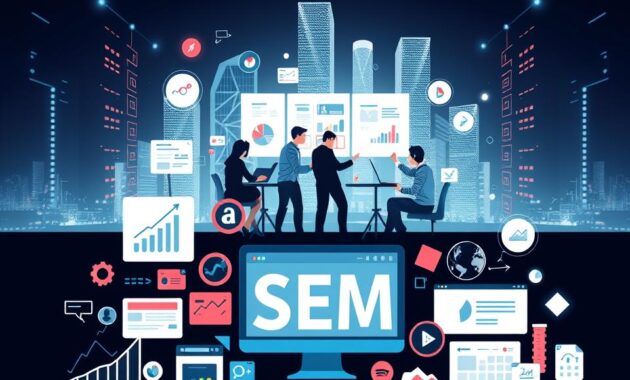In today’s digital landscape, having a strong online presence is key for businesses to succeed. Search Engine Marketing (SEM) is a vital strategy. It helps improve visibility, drive traffic, and increase conversions.
SEM is a powerful tool for businesses to reach their target audience. By using digital marketing techniques, companies can stay ahead. They can also achieve their marketing goals.
Key Takeaways
- Understanding the importance of SEM in digital marketing
- Learning how SEM can enhance business visibility
- Discovering strategies to drive traffic and boost conversions
- Exploring the role of SEM in achieving marketing goals
- Staying ahead of the competition with effective SEM techniques
What is Search Engine Marketing?
Search Engine Marketing (SEM) is a digital marketing strategy. It aims to boost a website’s visibility on search engine results pages (SERPs) through paid ads.
Definition and Core Components
SEM uses platforms like Google Ads to show ads on search engines. It includes keyword research, ad copy creation, and bid management. Knowing how search engines work is key to success in SEM.
The first step is finding the right keywords for ads. Then, creating ads that grab attention and encourage clicks is important.
SEM vs. SEO: Understanding the Difference
Many get confused between SEM and SEO. SEO aims to improve a site’s organic search rankings through content and technical tweaks. SEM, on the other hand, uses paid ads for quick visibility.
| Aspect | SEM | SEO |
|---|---|---|
| Nature | Paid Advertising | Organic Ranking |
| Visibility | Immediate | Gradual |
| Cost | Pay-per-click | Generally free, but may involve content creation costs |
Knowing the difference between SEM and SEO is vital. It helps businesses create a strong digital marketing plan. This plan uses both paid and organic channels well.
The Evolution of Search Engine Marketing
Search Engine Marketing (SEM) has seen a remarkable transformation over the years. As search engines grew, so did the ways we use SEM.
Historical Development
In the beginning, SEM used simple text ads. Later, it added better targeting and ad types. “The ability to reach customers when they’re looking for something has made SEM key in digital marketing,” experts say.
Current Trends and Future Directions
Now, SEM is shaped by artificial intelligence, voice search, and mobile-first indexing. As these techs get better, SEM needs to keep up. Today, we focus on personalization and making decisions based on data.
Key Benefits of Implementing Search Engine Marketing
Search Engine Marketing (SEM) can change the game for businesses wanting to grow online. It offers many benefits that boost digital marketing efforts.
Immediate Visibility and Traffic Generation
SEM gives businesses immediate visibility on search engine results pages (SERPs). This means more website traffic, as users find their way to relevant pages. With SEM, companies can attract targeted traffic and turn visitors into customers.
Highly Targeted Audience Reach
SEM enables highly targeted advertising. Businesses can reach their ideal audience with precision. By focusing on specific keywords, demographics, and locations, ads are seen by those most interested in what they offer.
Measurable ROI and Performance Tracking
SEM also offers measurable ROI and performance tracking. Advanced analytics tools let businesses monitor campaign performance in real-time. This helps make informed decisions to boost ROI.
Competitive Advantage in Crowded Markets
In today’s digital world, SEM gives businesses a competitive edge. By outbidding rivals and optimizing ads, companies can gain market share and stay competitive.
Essential Components of an Effective SEM Strategy
Creating a winning Search Engine Marketing (SEM) strategy needs a mix of several key parts. A solid SEM strategy is key to getting noticed, driving sales, and boosting your return on investment (ROI).
Comprehensive Keyword Research and Selection
The base of a great SEM campaign is keyword research. It’s about finding the right keywords and phrases people use to find what you offer. Tools like Google Keyword Planner and SEMrush help find keywords with lots of searches but not too much competition.
Compelling Ad Copy Creation and Testing
Writing compelling ad copy is vital to grab people’s attention. Your ad should be easy to understand, short, and match what people are searching for. Testing different ads helps find the best one.

Landing Page Design and Conversion Optimization
A good landing page turns visitors into buyers. It should match your ad, load fast, and have a clear call-to-action (CTA). Always improve your landing page based on what users say and how well it does.
Strategic Bid Management and Budget Allocation
Bid management and budget allocation are key parts of SEM. You need to decide how much to bid on keywords and spread your budget wisely to get the best return.
| SEM Component | Description | Importance |
|---|---|---|
| Keyword Research | Identifying relevant keywords | High |
| Ad Copy Creation | Crafting compelling ad copy | High |
| Landing Page Optimization | Optimizing landing pages for conversions | High |
| Bid Management | Strategic bidding on keywords | High |
Top SEM Platforms Review
The Search Engine Marketing (SEM) world is led by a few big names. Google Ads and Microsoft Advertising (Bing Ads) stand out the most.
Google Ads
Google Ads is the top choice for SEM. It has many features for different business needs.
Key Features
- Extensive keyword targeting options
- Advanced ad extensions
- Detailed performance tracking
- Integration with Google Analytics
Pros and Cons
Google Ads offers wide reach and audience targeting. But, it’s complex for new users. It also costs more for popular keywords.
Best Use Cases
Google Ads is best for quick visibility and traffic. It’s great for businesses with a strong online presence.
Microsoft Advertising (Bing Ads)
Microsoft Advertising, or Bing Ads, has unique features for some businesses.
Key Features
- Less competition compared to Google Ads
- Lower cost-per-click (CPC) in many cases
- Integration with Microsoft products
Pros and Cons
It has lower costs and less competition, good for small businesses. But, it doesn’t reach as many people as Google Ads.
Best Use Cases
Microsoft Advertising is best for cost-effective SEM. It’s good for targeting Bing users.
SEM Management Tools
SEM management tools are key for managing many campaigns.
Top Solutions for Different Business Sizes
| Business Size | Recommended Tool | Key Features |
|---|---|---|
| Small | SEMrush | Keyword research, competitor analysis |
| Medium | Ahrefs | Backlink analysis, content optimization |
| Large | Marin Software | Cross-channel campaign management, advanced reporting |
Selection Criteria and Recommendations
When picking an SEM management tool, look at ease of use and features. Also, check if it fits with your marketing stack.
Implementation Best Practices and Common Pitfalls
Understanding SEM well is key. It involves knowing the best ways to do it and avoiding common problems. Advertisers need to know how to steer clear of these issues.
Setting Realistic Goals and Timelines
Setting goals that are reachable is essential for SEM success. You need to know what your campaign can do, who you’re trying to reach, and who else is in the game. Make sure your goals are clear and you have a solid plan for when you want to achieve them.
Overcoming Budget Constraints
Dealing with a tight budget is a big challenge in SEM. To get around this, focus on long-tail keywords. Also, make your ad copy more appealing and make sure your landing pages are designed to get people to take action.
Dealing with Competitive Keywords
Keywords that lots of people want can be expensive. Think about using different keywords, use negative keywords to narrow down your audience, and keep an eye on and tweak your keyword strategy often.
| Challenge | Best Practice |
|---|---|
| Tracking and Attribution | Use conversion tracking and attribution modeling to understand campaign impact. |
| Ad Fatigue | Regularly refresh ad creative and rotate ad copy to maintain user engagement. |
Solving Tracking and Attribution Challenges
Getting tracking and attribution right is critical for knowing how well your SEM campaigns are doing. Use conversion tracking and attribution modeling to guide your decisions.
Avoiding Ad Fatigue and Maintaining Performance
Ad fatigue can really hurt your campaign’s performance. To fight this, update your ad creative often, change up your ad copy, and keep your landing pages fresh and interesting.
Conclusion
Search engine marketing (SEM) is key to a strong digital marketing plan. It helps businesses get more online visibility, attract the right visitors, and increase sales. By knowing how SEM works, companies can do better online.
A good SEM plan starts with finding the right keywords, writing catchy ads, and making landing pages work well. Using platforms like Google Ads and Microsoft Advertising helps reach the right people. It also lets businesses see how well their ads are doing.
In short, adding SEM to your digital marketing can really help. By using what you’ve learned here, you can make your SEM better, stay ahead, and meet your online goals. Remember, a good SEM plan keeps getting better. It needs regular checks and changes to keep up with search engines.


